Louis Bleriot Video - Picture
More Aviation History
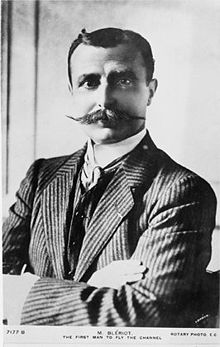
|
|
Louis Bleriot
Louis Bleriot

Born: 1 July 1872(1872-07-01)
Cambrai, France
Died: 2 August 1936(1936-08-02) (aged 64)
Paris, France
Nationality: French
Occupation: Inventor and engineer
Known for: First complete heavier-than-air flight over a large body of water,
first working monoplane
Louis Blériot (1 July 1872 - 2 August 1936) was a French aviator, inventor and engineer. In 1909 he completed the first flight across a large body of water in a heavier-than-air craft, when he crossed the English Channel. For this achievement, he received a prize of GB£1000 (5,000 dollars; US 1910). He also is credited as the first person to make a working monoplane. Blériot was a pioneer of the sport of air racing.
Early years
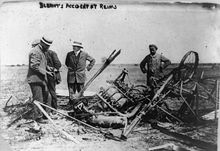
Picture - Wreckage of one of Blériot's planes, Reims Air Meet, August 1909.
Born in the village of Dehéries near Cambrai, Blériot studied engineering at the xcole Centrale Paris. He invented automobile headlights and established a successful acetylene headlamp business, amassing a small fortune.
He used the money from his business to experiment with towed gliders on the Seine River, learning about aircraft and flight dynamics. His interest in aviation manifested itself when, in 1900, he built an ornithopter, which failed to take off.
Blériot and collaborator Gabriel Voisin formed the Blériot-Voisin Company. Active between 1903 and 1906, the company developed several unsuccessful and dangerous aircraft designs, which drained his finances.
He then left and started creating his own airplanes, experimenting with various configurations and eventually creating the world's first successful monoplane-the Blériot V. This model crashed easily, however. By 1909, he had created the Blériot XI, which was more stable. Its first flight occurred on 23 January of that year, and later it was displayed at the Exposition de la Locomotion Aérienne in Paris in 1909.
The Channel crossing
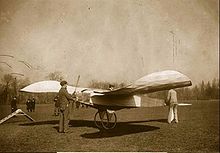
Picture - The first successful monoplane, built in January 1907
After years of honing his piloting skills, Blériot decided to try for the thousand-pound prize offered by the London Daily Mail for a successful crossing of the English Channel.
Blériot had two rivals for the prize, both of whom failed to complete the crossing. The first was Hubert Latham, a French national of English extraction. He was favoured by both the United Kingdom and France to win. He had arrived first and attempted the crossing on 19 July, but 6 miles (9.7 km) from his destination of Dover the Antoinette IV developed engine trouble and was forced to make the world's first landing of an aircraft on the sea.The other pilot, Charles de Lambert, was a Russian aristocrat with French ancestry, and one of Wilbur Wright's students. However, Lambert was injured in a major crash during a test flight, forcing him to quit the competition.
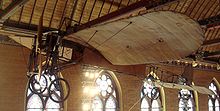
Picture - The Blériot XI, on which Blériot crossed the Channel in 1909. Musée des Arts et Métiers, Paris.
On 25 July 1909, the three rivals all arrived at the seaside town of Calais, France. Blériot had a badly burned foot, caused when a gasoline line broke on his #VIII machine during one of his trial runs. Despite this he did not withdraw. The #VIII was Blériot's largest and most successful design before the #XI. After the crash in the #VIII which had left him with the burnt foot, the #XI was the only aircraft he had available to make the Channel flight.
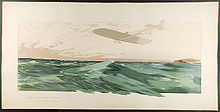
Picture - Bleriot crossing the Channel on 25 July 1909 - Ernest Montaut
The French government provided the destroyer Escopette to escort and observe his plane during the trip to Dover. (After his crash into the sea, Latham had been rescued by the French torpedo-destroyer Harpon on 19 July). Blériot used his own aircraft design, the Blériot XI, a structurally strong but simple and manoeuvrable monoplane. This was powered by a 25-horsepower, Anzani 3-cylinder semi-radiual (or fan) engine with a two-bladed fixed-pitch wooden propeller. His engine was barely as powerful as the smallest outboard motor found on a modern day pleasure boats.
He took off when dawn broke, just after 4:30 AM, on 25 July 1909. He later reported, in a telegram to The Washington Post, that he had needed to accelerate his engine to 1,200 revolutions per minute, almost its top speed, to clear telegraph wires at the edge of the cliff near the runway's field. Then he reduced his speed to give the XI an average airspeed of approximately 40 miles per hour (64 km/h) at an altitude of about 250 feet (76 m). Soon after, inclement weather began to form, with the Channel becoming rougher. Blériot lost sight of any landmarks, and rapidly outpaced the destroyer escort. He stated: â[f]or more than 10 minutes I was alone, isolated, lost in the midst of the immense sea, and I did not see anything on the horizon or a single shipâ.
Picture - The Blériot Memorial on the site of his landing near the cliffs above Dover (the bicycle handlebars are not part of the memorial)
The landing was in turbulent weather, causing problems for Blériot: rain was cooling the engine, putting it in danger of stalling, and the strong wind was blowing him off course. As Blériot reduced his airspeed for the landing, the gusts of wind nearly caused his plane to crash from an altitude of 20 meters (67 ft), when he cut off the engine. The landing severely damaged his landing gear, along with the propeller. However, the rest of the aeroplane was in good order and the landing was deemed successful.
He flew 22 statute miles (35 km) from Les Baraques (near Calais) to Dover. The trip took 37 minutes and Blériot became an immediate celebrity. The Blériot Memorial, the outline of the aircraft laid out in granite setts in the turf, now marks his exact landing spot on the cliffs above Dover. 51°07â²52â³N 1°19â²34â³E / 51.1312°N 1.326°E / 51.1312; 1.326.
This was not the first flight across the English Channel. On 7 January 1785, Jean-Pierre Blanchard and John Jeffries flew in a hydrogen balloon from Dover to Guignes, two leagues (approximately 6 miles (9.7 km)) from Calais.
Later life
Between 1909 and the outbreak of World War I in 1914, Blériot produced more than 800 aircraft, most of them variations of the Type XI model. However, the quality of the aircraft proved controversial as a result of the findings of inspections into several crashes. The British government put a temporary ban on them, until Blériot himself investigated and solved the problems that had caused the crashes.
In 1913, a consortium led by Blériot bought the Société pour les Appareils Deperdussin airplane manufacturer and he became the president of the company in 1914. He renamed it the Société Pour L'Aviation et ses Dérivés (SPAD); this company would go on to manufacture fighter planes used in World War I, including the SPAD S.XIII.
He attempted to set up a British subsidiary through the Blériot Manufacturing Aircraft Company Ltd. in England in 1916. Its listing was hijacked by a dishonest syndicate headed by Harry John Lawson, leaving the company unable to meet its obligations, and it was soon wound up. In 1917, Blériot tried again and built a factory in Addlestone, Great Britain.
After the war, Blériot formed his own company, Blériot Aéronautique, for the development of commercial aircraft, which was more successful than that founded by the Wright brothers. In the United States, however, a legal patent battle over the invention of the aileron erupted between the Wrights and Blériot: Blériot's aeroplanes were selling very well, but the Wright brothers did not receive any royalties from him, even though this technology for controlling aircraft was clearly their invention. This was eventually recognized by the courts.
Previously, prior to the outbreak of war in 1914, had opened flying schools at Brooklands, in Surrey, and at Hendon Aerodrome.
In 1927 Blériot, long retired from flying, was present to welcome Charles Lindbergh when he landed at Le Bourget field completing his transatlantic flight. The two men, separated in age by thirty years, had each made history by crossing famous bodies of water. Together they participated in a famous photo opportunity in Paris.
In 1934, Blériot visited Newark Airport in New Jersey and predicted commercial overseas flights by 1938.
Death
Blériot remained active in the aviation business until his death on 2 August 1936 in Paris of a heart attack. He was interred in the Cimetix¨re des Gonards in Versailles.
Legacy
In his honor, the Fédération Aéronautique Internationale established the "Louis Blériot medal" in 1936. The medal may be awarded up to three times a year to record setters in speed, altitude and distance categories in light aircraft, and is still being awarded.
On 25 July 2009, the centenary of the original Channel crossing, Frenchman Edmond Salis took off from Blériot Beach in an exact replica of Blériot's monoplane. He landed successfully in Kent at the Duke of York's Royal Military School.
In popular culture
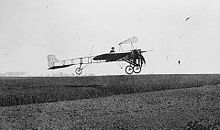
Picture -
In 2002, the English train company Virgin Trains introduced a new type of train called British Rail Class 221. One of these trains (number 221 101) was named Louis Blériot.
In 2006, Rivendell Bicycle Works introduced a bicycle model named the "Blériot 650B" as a tribute to Blériot. It features his portrait on the seat tube.
Blériot Aéronautique
First flying machine
List of early flying machines
List of firsts in aviation
Louis Bleriot Pictures
More aircraft.
Source: WikiPedia